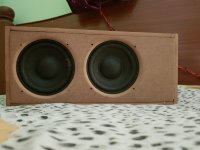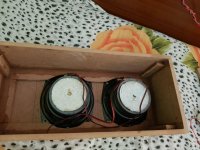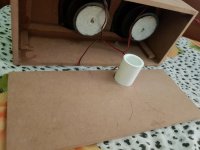Hello there,
I have a problem regarding to of my full range speakers.
Actually I made a Enclosure box with two 4" speaker ratted at 20 watts.
Volume of the Enclosure is around 165 cubic inches.
And the port that I have used is generally a pvc pipe socket which is 1 inch in diameter and 2 inches in length.
And the wood that I used to complete my enclosure is 8mm MDF wood.
My main problem that i am facing is that, when I play music like edm or bass boosted music, the Bass from the enclosure is like when you knock the door and the lows are good but if I stand about 10 feet from it.
Can anyone please suggest me any idea to increase my bass with good Lows and Beats. I just want to hear sound boomy but in this small enclosure.
Thank You.
I have a problem regarding to of my full range speakers.
Actually I made a Enclosure box with two 4" speaker ratted at 20 watts.
Volume of the Enclosure is around 165 cubic inches.
And the port that I have used is generally a pvc pipe socket which is 1 inch in diameter and 2 inches in length.
And the wood that I used to complete my enclosure is 8mm MDF wood.
My main problem that i am facing is that, when I play music like edm or bass boosted music, the Bass from the enclosure is like when you knock the door and the lows are good but if I stand about 10 feet from it.
Can anyone please suggest me any idea to increase my bass with good Lows and Beats. I just want to hear sound boomy but in this small enclosure.
Thank You.
Attachments
It is generally considered a good idea to use all 4 mounting points. Have you verified that the enclosure is airtight (with the tube plugged up)? The unused screholes and the are around the port seem a bit suspicious, and it's hard to tell how well the back seals up and where the cable passes through.
I would have placed the speakers as close together as possible, but it's too late for that now.
"Two 4" speaker ratted at 20 watts" is not a useful driver specification. Got any more comprehensive data? To calculate the enclosure you need at least three TSPs: fs, Vas and Qts. And since you have two drivers you have to use 2x Vas. With the data from a Visaton FR10 driver (90 Hz - 2.3 l - 0.54), I'm getting a volume of 11.8 liters (or 193 cu.in., reasonably close) and a BR tube length of 0.8 cm at best - that's more like 1/3", not 2". The tube is also a bit too small to begin with (rule of thumb is 1/3 of speaker dia., so more like 1-1/2").
I would have placed the speakers as close together as possible, but it's too late for that now.
"Two 4" speaker ratted at 20 watts" is not a useful driver specification. Got any more comprehensive data? To calculate the enclosure you need at least three TSPs: fs, Vas and Qts. And since you have two drivers you have to use 2x Vas. With the data from a Visaton FR10 driver (90 Hz - 2.3 l - 0.54), I'm getting a volume of 11.8 liters (or 193 cu.in., reasonably close) and a BR tube length of 0.8 cm at best - that's more like 1/3", not 2". The tube is also a bit too small to begin with (rule of thumb is 1/3 of speaker dia., so more like 1-1/2").
Thank You. But the problem.
Thank you sir,
But the problem is that I had these driver samples, so started thinking of why not use as a portable boombox with limited size.
And the Airtight concern you asked is that I am just testing the enclosure for bass, Haven't yet completed building it and all the gaps are still open.
But if I airtight the enclosure, will it produce good boomy bass? Or you can advise me any idea for example cotton or polyfill, or any other solutions?
I generally got excited from the Archeer A320 speaker, where in a little box it created huge bass. So just want to innovate something from it.
Your Specs are correct but i collect these drivers from an old system as they works well. So I dont have the data parameters.
Please help me sir to finish this project.
Thank You.
Thank you sir,
But the problem is that I had these driver samples, so started thinking of why not use as a portable boombox with limited size.
And the Airtight concern you asked is that I am just testing the enclosure for bass, Haven't yet completed building it and all the gaps are still open.
But if I airtight the enclosure, will it produce good boomy bass? Or you can advise me any idea for example cotton or polyfill, or any other solutions?
I generally got excited from the Archeer A320 speaker, where in a little box it created huge bass. So just want to innovate something from it.
Your Specs are correct but i collect these drivers from an old system as they works well. So I dont have the data parameters.
Please help me sir to finish this project.
Thank You.
How exactly do you perceive the bass to be lacking now? Is it not enough? Lacking in depth? Both?Thank you sir,
But the problem is that I had these driver samples, so started thinking of why not use as a portable boombox with limited size.
And the Airtight concern you asked is that I am just testing the enclosure for bass, Haven't yet completed building it and all the gaps are still open.
But if I airtight the enclosure, will it produce good boomy bass? Or you can advise me any idea for example cotton or polyfill, or any other solutions?
Getting things airtight is among the basic minimum requirements for any speaker that isn't an open baffle affair.
That's a Bluetooth speaker. You do know that these tend to have some sort of DSP capability including not only frequency response correction but also dynamic compression and psychoacoustic trickery like creating bass harmonics for more perceived bass, right? (You can buy dedicated ICs to do all of that.) In other words, getting the speaker part right is important but ultimately only part of the job.I generally got excited from the Archeer A320 speaker, where in a little box it created huge bass. So just want to innovate something from it.
The strength of DIY is in its flexibility - being able to react to very specific demands. However, trying to compete with good commercial products in a well-established market is likely to prove futile, as they tend to have a fair amount of R&D put into them.
Fair enough - but you can measure them using relatively modest tools. A decent multimeter, an assortment of resistors, some small and relatively precise weights (using coins is an old trick, as these tend to have rather well-defined and documented properties including weight - use the tiniest bit of tape or glue to hold them down as needed), a PC soundcard and some software (like ARTA or REW) and ideally a thermometer and barometer is about the maximum you should need.Your Specs are correct but i collect these drivers from an old system as they works well. So I dont have the data parameters.
A quick Google search for "thiele small parameter measure tutorial" turns up a good amount of material, including how to do it with REW or the more traditional method outlined by Rod Elliott. (Note that the weights to be added are mere suggestions - I'd be looking for something on the order of a typical Mms for a driver this size, which could be anywhere from around 2 g to 6 g. A weight too small would make it hard to gauge the difference in fs accurately, one far too big might push the driver into its nonlinear region. Nothing is keeping you from trying a few different ones and comparing results.)
How Treat Passively Peaky Fullrange DriversCan anyone please suggest me any idea to increase my bass with good Lows and Beats. I just want to hear sound boomy but in this small enclosure.
- Status
- This old topic is closed. If you want to reopen this topic, contact a moderator using the "Report Post" button.


